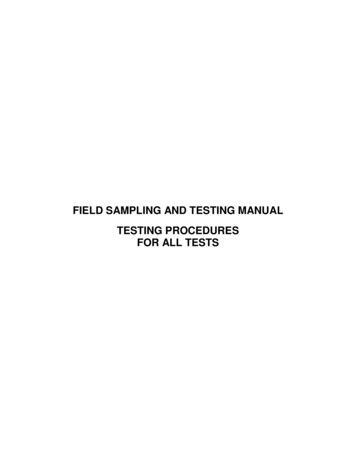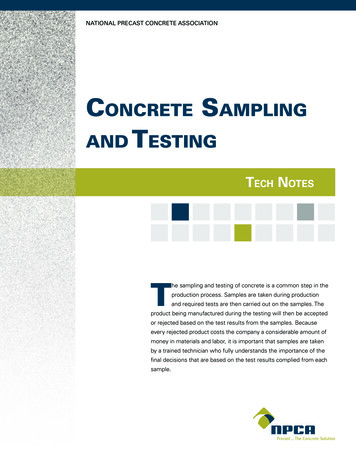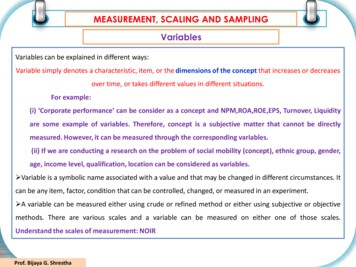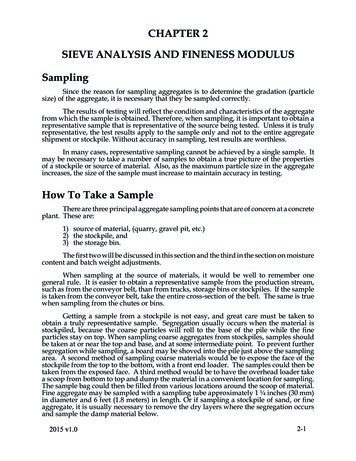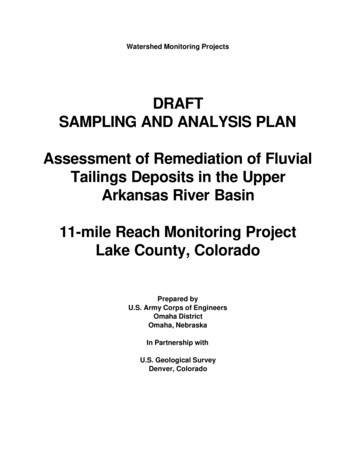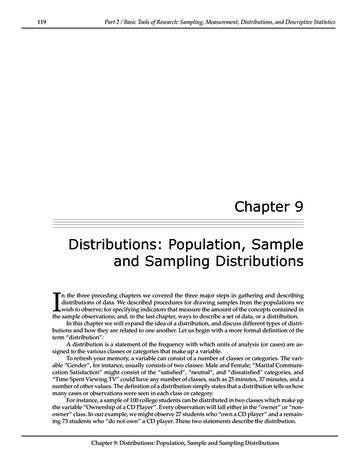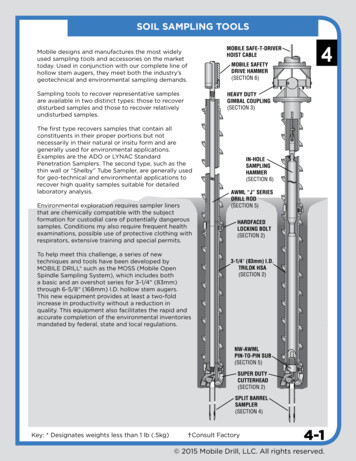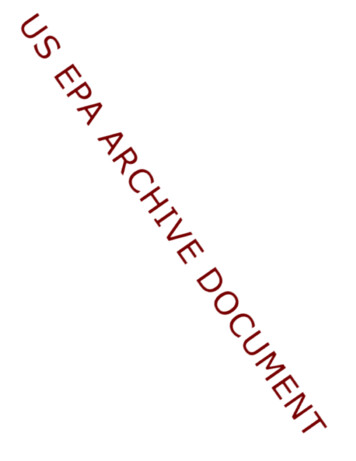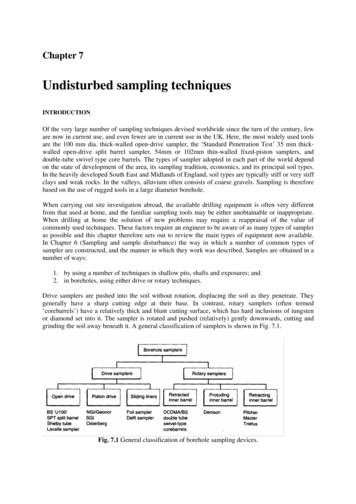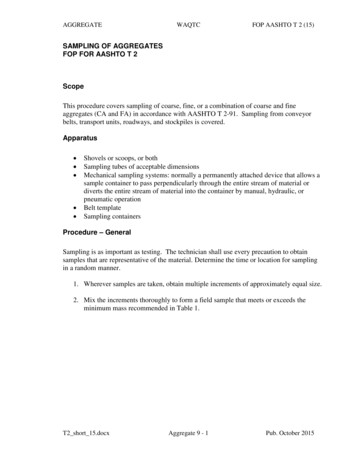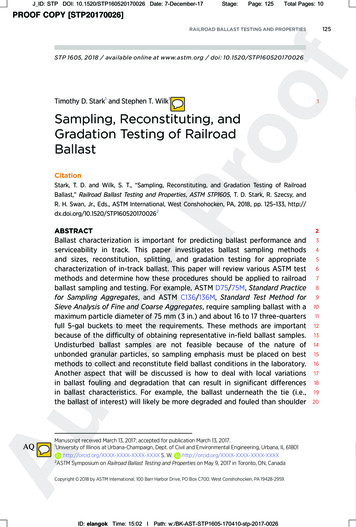
Transcription
J ID: STP DOI: 10.1520/STP160520170026 Date: 7-December-17Stage:Page: 125Total Pages: 10PROOF COPY [STP20170026]125RAILROAD BALLAST TESTING AND PROPERTIESSTP 1605, 2018 / available online at www.astm.org / doi: 10.1520/STP160520170026Timothy D. Stark1 and Stephen T. Wilk11Sampling, Reconstituting, andGradation Testing of RailroadBallastCitationStark, T. D. and Wilk, S. T., “Sampling, Reconstituting, and Gradation Testing of RailroadBallast,” Railroad Ballast Testing and Properties, ASTM STP1605, T. D. Stark, R. Szecsy, andR. H. Swan, Jr., Eds., ASTM International, West Conshohocken, PA, 2018, pp. 125–133, Ballast characterization is important for predicting ballast performance andserviceability in track. This paper investigates ballast sampling methodsand sizes, reconstitution, splitting, and gradation testing for appropriatecharacterization of in-track ballast. This paper will review various ASTM testmethods and determine how these procedures should be applied to railroadballast sampling and testing. For example, ASTM D75/75M, Standard Practicefor Sampling Aggregates, and ASTM C136/136M, Standard Test Method forSieve Analysis of Fine and Coarse Aggregates, require sampling ballast with amaximum particle diameter of 75 mm (3 in.) and about 16 to 17 three-quartersfull 5-gal buckets to meet the requirements. These methods are importantbecause of the difficulty of obtaining representative in-field ballast samples.Undisturbed ballast samples are not feasible because of the nature ofunbonded granular particles, so sampling emphasis must be placed on bestmethods to collect and reconstitute field ballast conditions in the laboratory.Another aspect that will be discussed is how to deal with local variationsin ballast fouling and degradation that can result in significant differencesin ballast characteristics. For example, the ballast underneath the tie (i.e.,the ballast of interest) will likely be more degraded and fouled than shoulderAQManuscript received March 13, 2017; accepted for publication March 13, 2017.1University of Illinois at Urbana-Champaign, Dept. of Civil and Environmental Engineering, Urbana, IL 61801http://orcid.org/XXXX-XXXX-XXXX-XXXX S. W.http://orcid.org/XXXX-XXXX-XXXX-XXXX2ASTM Symposium on Railroad Ballast Testing and Properties on May 9, 2017 in Toronto, ON, CanadaC 2018 by ASTM International, 100 Barr Harbor Drive, PO Box C700, West Conshohocken, PA 19428-2959.Copyright VID: elangok Time: 15:02 I Path: 121314151617181920
J ID: STP DOI: 10.1520/STP160520170026 Date: 7-December-17Stage:Page: 126Total Pages: 10PROOF COPY [STP20170026]126STP 1605 On Railroad Ballast Testing and Propertiesor crib ballast, but this is also the most difficult location to obtain withouttrack disturbance.2122Keywordsballast, rockfill, ballast sampling, sieve analysis23Introduction24Railroad ballast is a uniformly graded aggregate that provides support to tracksuperstructure (i.e., crossties and rails). As a result, it is the uppermost support anddamping system for the static and dynamic loads applied to the track by passingtraffic. Understanding the gradation, compressibility, shear strength, and stiffnessof ballast is important for assessing track support and load distribution among adjacent ties during train loading because the ballast layer plays a significant role intrack displacement and settlement [1].To address these issues, the main objective of this study is to provide recommendations for the appropriate ballast sampling techniques, sample and specimenmasses, and sample splitting techniques. Most of these ballast testing topics are discussed in relevant ASTM test methods and are presented here. However, two ofthese topics are not specifically addressed in applicable ASTM test methods. Theseare obtaining a field sample of ballast that is representative of field track conditionsand how to reconstitute the field sample in the laboratory to obtain a representativetest specimen for gradation and shear testing. For example, no prior study wasfound in which the field sampling procedure collected a sufficient mass or weight ofballast to be in accordance with current ASTM test methods. This is importantbecause the National Stone, Sand, and Gravel Association [2] states, “ A samplewhich is too small is of no value and represents wasted effort.” If laboratories useidentical sampling, remixing, splitting, and testing procedures, the test resultsshould be more comparable and eliminate biases due to sampling, remixing, splitting, and testing procedures in the ballast properties.This paper covers the following main topics: ballast gradations tested hereinand typical gradations and appropriate sampling, remixing, sample splitting, andgradation testing procedures.Ballast TestedThis section describes the ballast material used herein to establish the minimumsample and specimen masses required for ASTM test methods for gradation andshear strength testing. Clean granite ballast tested herein was obtained from theVulcan Materials Co. quarry near Atlanta, GA. The product name for the materialtested is “#4 Aggregate Material” and is termed “railroad ballast” by the producer.This material is referred to as “#4 Aggregate” herein.Fig. 1 shows the grain size distribution of the #4 Aggregate, which has a specificgravity of 2.63 when tested in accordance with ASTM C127, Standard Test MethodID: elangok Time: 15:02 I Path: 565758
J ID: STP DOI: 10.1520/STP160520170026 Date: 7-December-17Stage:Page: 127Total Pages: 10PROOF COPY [STP20170026]127STARK AND WILK, DOI: 10.1520/STP160520170026FIG. 1 Grain size distribution of clean granite ballast tested herein (#4 Aggregate) andAREMA No. 24.for Density, Relative Density (Specific Gravity), and Absorption of Coarse Aggregate[3]. The granite aggregate size distribution is a little finer than American RailwayEngineering and Maintenance-of-Way Association (AREMA) No. 24 ballast gradation but is considered to be representative of main line ballast.Gradation TestsThis section discusses appropriate sample locations, masses, and test procedures forlaboratory ballast gradation (i.e., particle size) analyses that should be used to assessthe gradation of clean and fouled ballast. This is important because ballast gradation has been shown to affect testing results [4], so ensuring the sample size is representative and large enough to simulate field ballast (quarry, stockpile, or tracksection) is important for obtaining meaningful results. For example, obtaining oneor two buckets of ballast, as illustrated in Fig. 2, is usually not an adequate samplemass to properly represent the ballast and therefore is inadequate for measuring thegradation of the quarry or stockpiled material. Additionally, improper transportand remixing of the ballast buckets can lead to unrepresentative material gradations, especially in fouled ballast because vibration during transport will cause thefine particles to segregate from the larger ballast particles.Three ASTM procedures are discussed here to provide recommendations for(1) sample mass required to properly measure the field ballast gradation: ASTMD75/D75M, Standard Practice for Sampling Aggregates [5], and ASTM C136/136M,Standard Test Method for Sieve Analysis of Fine and Coarse Aggregates [6];ID: elangok Time: 15:02 I Path: 656667686970717273747576777879
J ID: STP DOI: 10.1520/STP160520170026 Date: 7-December-17Stage:Page: 128Total Pages: 10PROOF COPY [STP20170026]128STP 1605 On Railroad Ballast Testing and PropertiesFIG. 2 Typical ballast stockpile sampling and filling buckets with stockpiled ballast(photos courtesy of Samuel C. Douglas).(2) method for splitting or reducing the sample mass to gradation testing size:ASTM C702/C702M, Standard Practice for Reducing Samples of Aggregate to Testing Size [7]; and (3) procedure for performing sieve analysis of ballast: ASTMC136/136M.The large ballast particle sizes make ballast sampling a laborious process, andextracting large amounts of ballast from service track is often unrealistic. TheASTM methods are the procedural standards for aggregate and therefore should beapplied to ballast testing. Innovative methods to replace sampling may be necessaryand are discussed in subsequent sections.ASTM D75/D75M, STANDARD PRACTICE FOR SAMPLING AGGREGATESGuidelines for securing ballast samples and required sample masses for ballast arepresented in ASTM D75/D75M and ASTM C136/C136M, so both of these requirements should be reviewed and followed. ASTM D75/D75M provides recommendations for proper ballast sampling to reduce particle segregation and therefore bias inlaboratory test results. Flowing aggregate streams or conveyor belts are recommended, and Section 5.3.1 of ASTM D75/D75M does not recommend samplingcoarse aggregate from stockpiles or rail cars especially when determining aggregateproperties that are dependent upon gradation, such as shear strength, because ofparticle segregation. This makes typical or common ballast stockpile sampling, suchas that shown in Fig. 2a, less desirable than an aggregate stream. However, if stockpile samples must be used, Section 5.3.3.2 of ASTM D75/D75M recommends asampling procedure to reduce particle segregation involving sampling various locations of the stockpile and combining the samples. This is also referred to as the“mini-stockpile method.”Both Section 5.4.2 of ASTM D75/D75M and Section 7.4 of ASTM C136/C136M [6] provide suggested sample masses for routine grading and quality analyses, which are summarized in Fig. 3. Unfortunately, ASTM C136/C136M, discussedhere, can require a greater sample mass than ASTM D75/D75M, so engineers mustID: elangok Time: 15:02 I Path: 07
J ID: STP DOI: 10.1520/STP160520170026 Date: 7-December-17Stage:Page: 129Total Pages: 10PROOF COPY [STP20170026]129STARK AND WILK, DOI: 10.1520/STP160520170026FIG. 3 ASTM D75/D75M and ASTM C136/C136M required aggregate sample masses.consider the requirements of both ASTM D75/D75M and ASTM C136/C136Mbefore ballast sampling to ensure the appropriate sample mass is obtained. ASTMC136/C136M covers the test method for determining particle size distribution ofcoarse aggregates by sieving and requires: (1) the greater of the sample massesrequired under ASTM D75/D75M and ASTM C136/C136M or (2) four times thesample mass under ASTM C136/C136M. If additional testing (e.g., shear strength)is to be performed, additional sample mass should be obtained so the properamount can be extracted for the other testing.For example, using the Dmax of 56 mm (2.2 in.) from Fig. 1 for the #4 Aggregate tested herein, ASTM D75/D75M requires a sample mass between 100 kg and125 kg (220 lb and 275 lb), while ASTM C136/C136M requires a sample mass ofbetween 80 kg and 140 kg (176 lb and 309 lb). Of course, the larger of these samplemasses, that is, 140 kg (309 lb), should be obtained in the field for gradation testing,and an additional sample should be obtained for other testing. Using the volume of a18.9-L (5-gal) bucket as about 0.02 m3 (0.65 ft3), this means four to five fullID: elangok Time: 15:02 I Path: 112113114115116117118119120121122
J ID: STP DOI: 10.1520/STP160520170026 Date: 7-December-17Stage:Page: 130Total Pages: 10PROOF COPY [STP20170026]130STP 1605 On Railroad Ballast Testing and Propertiesbuckets—or realistically five to six three-quarters full buckets—of ballast are requiredfor a 140-kg (309-lb) sample based on a unit weight of 17.3 kN/m3 (110 pcf).However, for values of Dmax greater than or equal to 75 mm (3 in.), the samplesize required for ASTM C136/C136M is greater than that required under ASTMD75/D75M. For example, using Dmax of 90 mm (3.5 in.), the samples sizesrequired under ASTM D75/D75M and ASTM C136/C136M are 175 kg (385 lb)and 400 kg (880 lb), respectively. To meet the requirement of ASTM C136/C136M,that is, 400 kg (880 lb), 16 to 17 three-quarters full 18.9-L (5-gal) buckets based ona unit weight of 17.3 kN/m3 (110 pcf) are required.123124125126127128129130131ASTM C702/C702M, STANDARD PRACTICE FOR SPLITTING OR REDUCINGAGGREGATE SAMPLE SIZE132133ASTM C702/C702M [7] presents two methods for splitting or reducing large samples of aggregate to the appropriate specimen size for gradation testing to minimizevariations in measured characteristics among tests. This is important because thefollowing section shows that a test specimen with a mass of about 34.8 kg (80 lb)must be obtained or split from the original sample mass of 100 kg to 125 kg (220 lbto 275 lb) for gradation testing of the #4 Aggregate gradation shown in Fig. 1.Under Section 5.2 of ASTM C702/C702M, the two methods presented for splitting or reducing large samples of coarse aggregate are: (1) using a mechanical splitter in accordance with Method A of ASTM C702/C702M, which is the preferredmethod and (2) quartering the sample on a hard, clean, and level floor in accordance with Method B of ASTM C702/C702M. Under clean and careful conditions,the mechanical splitter appears to provide the best method of obtaining a representative sample for all particle sizes, particularly the fouling material.Assuming a representative ballast sample can be obtained in the field with sample masses that comply with ASTM D75/D75M and ASTM C136/C136M, the keyto obtaining good test results is the remixing and splitting of the field sample. However, it is difficult to standardize the laboratory remixing and splitting processesespecially when fouled ballast is involved. If laboratories use the same remixing,splitting, and testing procedures, the test results should be more comparable, whichshould eliminate the bias from different remixing, split
Unfortunately, ASTM C136/C136M, discussed. 106. here, can require a greater sample mass than ASTM D75/D75M, so engineers must. 107. PROOF COPY [STP20170026] FIG. 2. Typical ballast stockpile sampling and filling buckets with stockpiled ballast (photos courtesy of Samuel C. Douglas). J_ID: STP DOI: 10.1520/STP160520170026 Date: 7-December-17 Stage: Page: 128 Total Pages: 10 ID: elangok
